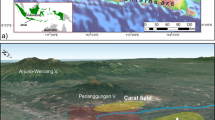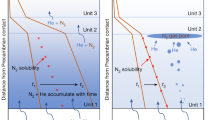Abstract
The thermal generation of hydrocarbon gases in sedimentary systems is generally thought to be an exclusively high-temperature process1, although previous work has indicated that significant generation may take place at burial temperatures as low as 65 °C (ref. 2). Here we present the carbon-isotope signatures of gases from the Western Canadian sedimentary basin. The isotope data show that low-temperature thermal generation of non-methane hydrocarbons occurs at temperatures lower than 62 °C and possibly as low as 20 °C. We can distinguish between gases of shallow3,4 and deep origin by using the carbon-isotope compositions of the non-methane components (ethane, propane and butane); the shallow gases have isotopic compositions consistent with a thermal origin, whereas the deep gases—although of abiogenic origin—bear isotopic signatures that have been biologically altered. These findings have allowed the development of a successful tool for detecting the source of leaking gases around oil wells in this basin, enabling cheaper and more effective remediation.
This is a preview of subscription content, access via your institution
Access options
Subscribe to this journal
Receive 51 print issues and online access
$199.00 per year
only $3.90 per issue
Buy this article
- Purchase on Springer Link
- Instant access to full article PDF
Prices may be subject to local taxes which are calculated during checkout




Similar content being viewed by others
References
Tissot, B. P. & Welte, D. H. Petroleum Formation and Occurrence: A New Approach to Oil and Gas Exploration (Springer, Berlin, (1978).
Price, L. C. Primary petroleum migration from shales with oxygen-rich organic matter. J. Petrol. Geol. 12, 289–324 (1989).
Rich, K., Muehlenbachs, K., Uhrich, K. & Greenwood, G. Carbon isotope characterization of migrating gas in the heavy oil fields of Alberta, Canada. Soc. Petrol. Eng. 30265, 215–224 (1995).
Deroo, G., Powell, T. G., Tissot, B. & McCrossan, R. G. The origin and migration of petroleum in the Western Canadian Sedimentary basin, Alberta. Geol. Surv. Can. Bull. 262 (1977).
Leckie, D. A., Bhattacharya, J. P., Block, J., Gilboy, C. F. & Norris, B. in Geological Atlas of the Western Canadian Sedimentary Basin (eds Mossop, G. D. & Shetsen, I.) 335–352 (Can. Soc. Petrol. Geol. Alberta Res. Council, Calgary, (1994).
Bustin, R. M. Organic maturity in the western Canada sedimentary basin. Int. Coal Geol. 19, 319–358 (1991).
Osadetz, K. G., Pearson, D. E. & Stasiuk, L. Paleogeothermal gradients and changes in the geothermal gradient field of the Alberta Plains. Curr. Res. C Geol. Surv. Can. Pap. 90-1D, 165–178 (1990).
England, T. D. J. & Bustin, R. M. Thermal maturation of the western Canada sedimentary basin south Red Deer River: 1) Alberta plains. Bull. Can. Petrol. Geol. 34, 71–90 (1986).
Schoell, M. The hydrogen and carbon isotopic composition of methane from natural gases of various origins. Geochim. Cosmochim. Acta 44, 649–661 (1980).
James, A. T. Correlation of natural gas by use of carbon isotopic distribution between hydrocarbon components. Am. Assoc. Petrol. Geol. Bull. 67, 1176–1191 (1983).
Clayton, C. Carbon isotope fractionation during natural gas generation from kerogen. Mar. Petrol. Geol. 8, 232–240 (1990).
Chung, H. M., Gormly, J. R. & Squires, R. M. Origin of gaseous hydrocarbons in subsurface environments: theoretical considerations of carbon isotope distribution. Chem. Geol. 71, 97–103 (1988).
James, AT. Correlation of reservoired gases using the carbon isotopic compositions of wet gas components. Am. Assoc. Petrol. Geol. Bull. 74, 1441–1458 (1990).
Martini, A., Budai, A., Walters, L. & Schoell, M. Economic accumulations of biogenic methane. Nature 383, 153–158 (1996).
Fuex, A. N. The use of stable carbon isotopes in hydrocarbon exploration. J. Geochem. Explor. 7, 155–188 (1977).
Rooney, M. A., Claypool, G. E. & Chung, H. M. Modeling thermogenic gas generation using carbon isotope ratios of natural gas hydrocarbons. Chem. Geol. 126, 219–232 (1995).
Mango, F. D., Hightower, J. W. & James, A. T. Role of transition-metal catalysis in the formation of natural gas. Nature 368, 536–538 (1994).
Berner, U. & Faber, E. Empirical carbon isotope/maturity relationships for gases from algal kerogens and terrigenous organic matter, based on dry, open-stystem pyrolysis. Org. Geochem. 24, 947–955 (1996).
Butala, S. J.et al. Mineral-catalyzed formation of natural gas during coal maturation. Am. Assoc. Petrol. Geol. Ann. Conv. Abstr. 1, 102 (1998).
Erno, B. & Schmitz, R. in Tech. Meeting Petrol. Soc. Can. Inst. Mining Vol. 94 paper 73 (1994).
Taylor, S. W., Sherwood-Lollar, B., Wasenaar, L. & Hendry, M. J. Bacterial hydrocarbon production in a shallow bedrock aquifer and surficial till aquitards, Saskatchewan, Canada. Geol. Soc. Am. Abstr. 29, 186 (1997).
Acknowledgements
We thank K. Muehlenbachs, S. Talman and A. T. James for discussions that helped to improve the original manuscript; L. C. Price for reviews of the first draft; and Husky Oil Operation Ltd for providing samples. The Canadian Association of Petroleum Producers supported this research.
Author information
Authors and Affiliations
Corresponding author
Rights and permissions
About this article
Cite this article
Rowe, D., Muehlenbachs, A. Low-temperature thermal generation of hydrocarbon gases in shallow shales. Nature 398, 61–63 (1999). https://doi.org/10.1038/18007
Received:
Accepted:
Issue Date:
DOI: https://doi.org/10.1038/18007
This article is cited by
-
Natural Gas Genesis, Source and Accumulation Processes in Northwestern Qaidam Basin, China, Revealed by Integrated 3D Basin Modeling and Geochemical Research
Natural Resources Research (2023)
-
Coupled hydro-mechanical XFEM analysis for multi-fracturing through an excavation driven by an underlying aquifer: a forensic case study
Acta Geotechnica (2023)
-
Catalytic production of low-carbon footprint sustainable natural gas
Nature Communications (2022)
-
Formation mechanism and geochemical characteristics of shallow natural gas in heavy oil province, China
Science in China Series D: Earth Sciences (2008)
-
Genetic identification of natural gases from shallow reservoirs in some oil- and gas-bearing basins of China
Chinese Journal of Geochemistry (2005)
Comments
By submitting a comment you agree to abide by our Terms and Community Guidelines. If you find something abusive or that does not comply with our terms or guidelines please flag it as inappropriate.



